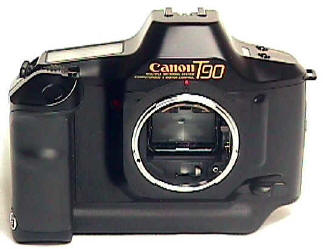
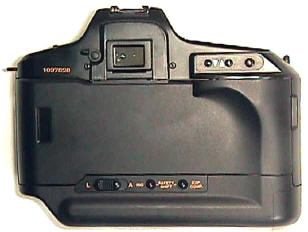
Home Camera Articles FOR SALE Orders I Buy / Wants Repairs Books Adapters
Canon T90: Best film Canon SLR Ever?
The only bad thing I have to say about the T90 is that it does not have a Nikon name plate, but I guess you can't have everything.


Introduced in 1986, the Canon T90 was years ahead of anything else on the market at that time. It is, quite simply, one of the best manual focus 35mm SLR designs of all time. Many features of the T90 were later incorporated into the EOS. Personally though, I like the total design of the T90. It gets my vote as the best Canon Design ever. I've been told Japanese Photojournalists called it "The Tank" for its ruggedness. Features include:
Motordrive up to 4.5 fps with FD lenses in full aperture mode, automatic motorized rewind, choice of 4.5 fps, 2 fps, single exposure, 5 fps frames possible in stop down mode.
Multi-mode operation: Manual operation with digital "match needle" metering, aperture priority, shutter priority, SEVEN auto-exposure programs, stopped down aperture priority, stopped down manual, plus automatic TTL Flash!
"Safety Shift" allows override of shutter priority and aperture priority settings if correct exposure range is outside the chosen setting.
THREE ambient light metering patterns: Centerweighted, partial pattern with 13 degree angle (shown by the outside circle around the center of the focusing screen), and spot metering with 3 degree angle (shown by the outer edge of the microprism focusing of the focusing screen). The spot metering is especially sophisticated, allowing the shooter to take up to 9 different readings. centerweighted and partial readings are taken off the focusing screen. Spot readings and flash readings are taken by the silicon cell in the bottom of the mirror box.
VERY advanced metering features are the Shadow and Highlight exposure compensation buttons located on the back top of the camera -- perfect for thumb operation. Take a spot meter reading of the highlight or shadow, and then use the respective button to compensate to bring the tone to the proper exposure -- since any meter only reads 18% gray. You can choose how much, or how little compensation you make just.
Exposure range is a wide EV 0 to 20 at ASA 100. DX or manual ASA setting. Film speed range 6 to 6400.
TTL flash, offering both centerweighted and amazingly enough, SPOT flash metering with the 300TL...the only camera I know that offers this feature. Also available was the excellent Macro Ringlight ML-2.
Extremely easy to read full information digital viewfinder readout. Below the focusing screen in horizontal small red LED's are the shutter speed, f/stop and exposure mode. This readout is EXTREMELY easy and convenient to read. The side of grip has a hidden panel where you can set the LED brightness. On the right side, vertically, is the exposure LCD indicators including spot readings and frame remaining.
Multiple exposure capability, up to 9 exposures possible.
An extraordinarily (at least for me) comfortable to hold body and grip. I wish Nikon did it this well.
Shutter speeds ranging from 1/4000th down to 30 seconds, with flash sync at 1/250th. Manual half stop settings.
Six Interchangeable bright focusing screens. Screens are interchanged through the mirror box with a special tool provided with the screen. My favorite is the hard to find Type L with central rangefinder split into four parts.
Other features include a cancelable self timer between 2 to 10 seconds, exposure compensation plus or minus two stops in 1/3 stop increments, exposure lock with depressed shutter release, very smooth electronic shutter release, depth of field preview, battery check, and rewind before the end of the roll.
Incredible flexibility with OTHER manufacture's lenses. By installing the Canon E, P, A, or N adapters, you can turn your T90 into a stop down aperture priority camera with TTL flash for Exakta, Pentax screw mount, Leica Visoflex, or Nikon lenses!!
While the T90 does not have interchangeable finders, the Canon 90 degree angle viewer which attaches to the eyepiece does an excellent job.
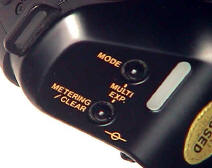
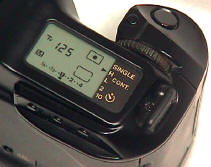
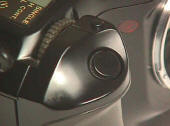
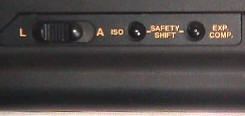

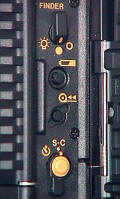
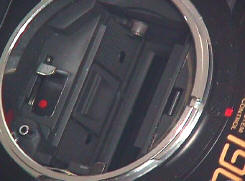
A silicon cell in the bottom of the mirror box reads flash off the film plane during exposure.
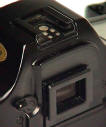

The shutter has a blind to shut out extraneous light for self timer or intervolmeter shots. The Canon right angle finder which fits over the square eyepiece is hard to find, but the Contax right angle finder is still in production and works just fine. The T90 is powered by the easy to find anywhere on the planet AA batteries.....too bad this was not continued in the EOS lineup.
Negatives? The designers did have one oversight -- no PC flash sync outlet. At one time Canon offered a service to add sync outlets at their authorized repair stations. Obviously it can still be done by a good repairman. You can get around it by using a small flash or radio control on your camera to slave fire your strobes.
A bigger disadvantage is that parts are getting harder to get. In 1998 Canon stopped providing parts for the T90 in the US -- though I do not know parts availability in the rest of the world. But the thing that bugs me the most is the T90 does not say "Nikon" on the front cover! Oh well.
The T90 is part of the huge Canon FD system -- the 2nd largest manual focus SLR system in photography. With a wide choice of bodies and virtually any accessory or lens, the Canon FD System is a versatile professional system capable of practically anything in 35mm. While some will argue the virtues of Canon FD glass Vs Nikon, for all practical purposes they are very very close to the same. The best lenses for the T90 are Canon's L series, which includes my Canon favorites: the 14/2.8, 24/1.4, 50/1.2, and 85/1.2.
Canon had four breech mount variations: 1) the original R mount for the 1959 Canonflex 2) the FL mount which used stop down metering 3) the FD mount which used open aperture metering and 4) the "bayonet" mount modification of 1980 introduced for quicker lens changing. Types 1, 2 and 3 are identifiable by the R, FL, or FD designations on their filter ring. Type 4, sometimes called FDn by its admirers, sometimes called not so nice names by its detractors, is identifiable by its black plastic mount which rotates the lens on and off the camera, rather than rotating a metal breech lock like the previous versions. These later lenses sometimes have plastic barrels which the earlier lenses did not. Personally I prefer the last mount due to it's MUCH faster lens changing. Purest claim the earlier mounts are better made and stronger...some even going so far as to pay a premium for those lenses. While the R mount lenses have the same breech mount and back focus, their internal mechanics will not mate with later cameras to offer either metering or auto-diaphragm operation. Be careful mounting R lenses to later camera bodies...you may damage your camera, or lens, or both.
For years Canon made a big deal of its breech mount, claiming it would show much less wear over the years than a bayonet mount (like Nikon's). The disadvantage is slower than bayonet lens mounting, various linkages protruding beyond the end of the rear lens mount which makes handling the lenses not so easy in your camera bag, and rear lens caps which often do not go on quickly. But, you get used to it after a while. It's interesting to note that after more than two decades of competing with Nikon's bayonet mount and singing the praises of their own breech lock mount, Canon switched to a bayonet mount for their autofocus EOS cameras. Hmmmm.
The T90's strong point is the overall integration of a very intelligent and well thought out design. The sum is more than the individual parts. You really have to use it to know what I am talking about -- a rare combination of great handling, intelligent controls, and incredible versatility.
Right now T90's are very under priced for what they are. It is only a matter of time until prices start going up.
Revised: November 14, 2011 . Copyright � 1998-2002 Stephen Gandy. All rights reserved. This means you may NOT copy and re-use the text or the pictures in ANY other internet or printed publication of ANY kind. Information in this document is subject to change without notice. Other products and companies referred to herein are trademarks or registered trademarks of their respective companies or mark holders.